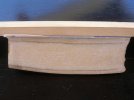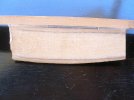- Joined
- Apr 4, 2010
- Messages
- 251
I'm going to slab a beach walrus tusk and have been reading about methods others use. So far I have read to glue the tusk to a board and run the board against the fence of the band saw. I have a 64 1/2" metal cutting band saw would it be appropriate for this task? Is a new band saw blade necessary? When I glue the tusk to the board which adhesive should be used, epoxy, wood glue, super glue? Also to get a good connection to the board I plan to cut one side of the tusk flat. Since the width of the tusk changes the boards edge needs to mimic the change in the tusks width, in order to keep the blade in the center of the tusk? I have read to run the blade as if I'm cutting steel and to go slow and easy. Is this a good approach. I'll only get one shot to get this right so any tips would be appreciated. Is stabilizing the scales recommended?
Thanks
Tim
Thanks
Tim


